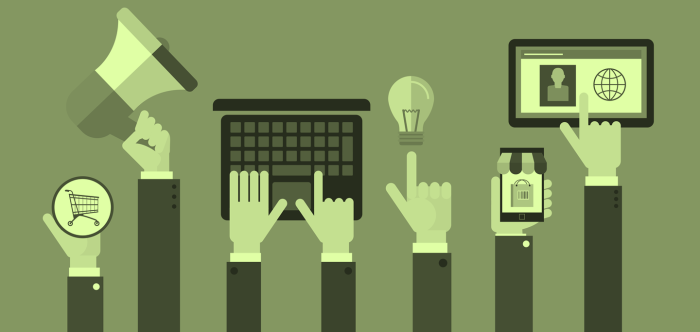
– by Sandeep Menon
Follow @samenon
“Digital is just another channel after all!’
Every time I hear this sentence, I start feeling somewhat anxious. The statement strikes me to be a bit like watching a rocket ship take off and remarking that “it’s just burning gases, after all”. Yes, it is. But that completely misses the point about something significant taking place, beyond the obvious.
Yes, digital is a channel. But it is also a lifestyle which makes it exceedingly powerful. It has the ability to completely redefine how we live, laugh and love. Entire lives are being lived online. This changes everything and that is true of the marketing space as well, where we are seeing a massive domain shift in the very practice of marketing. The traditional “campaign led” practice of marketing is slowly being replaced with the “experience” led practice. The way we plan, create, measure, track and optimize; everything has changed. The net result is that a new breed of marketers are now required, who are not wedded to the old ways of doing things.
The task of driving specific marketing outcomes or consumer action through targeted, linear “campaigns” is now being replaced by a real time, diffused set of activities that lead to an “experience”. Marketing outcomes no longer depend on whether a target moves through measured steps from being a prospect to a customer. Rather it depends on ensuring that he or she experiences the brand viscerally in a certain way, simultaneously, across multiple touch points. Some of these touch points could be digital such as websites, buying platforms, social media etc. while some could be offline such as retail outlets and word of mouth, while some like user reviews could span both domains. The ability to orchestrate this symphony effectively across multiple experience points and thus lead the customer magically towards desired action is the new holy grail of marketing!
In the process some important lessons need to be unlearned and re-learned. What are they?
1. The line is blurring between paid, owned and earned media.
The fact that PR & marketing are no longer separate streams has been acknowledged for a while. What is happening now is that even the definition of whether something is paid for, influenced or completely random is getting blurred in the digital world. It’s difficult to define whether a paid blog, shared on a social site and made viral by influencers is PR or marketing. And no one bothers defining it any more. It just gets integrated into one planning process. Companies that still run separate PR, marketing and Corp Comms divisions need to take a hard look at whether they are duplicating effort & wasting money. In short, are your messaging platforms aligned to create a unified experience for the consumer?
2. Creative content is back in the driving seat. It’s bigger and stronger than ever before.
There are no captive audiences any more. In the old days, you could block prime time slots and beam your message across to mass audiences who had no choice but to consume your content. This led to a certain “democratization” of content. Large factory model agencies churned out “acceptable” creative backed by solid media buying and placement capability. But all that has changed now. In the digital world, individuals decide what, where and when they will consume in terms of content. If the content is not engaging, they quickly move on. This means that contrary to what happened in the maturing phase of advertising, creativity is now back with a bang. The next decade will see a slew of new businesses rise around the art of creating engaging and entertaining content. And in formats ranging from long form text to video to gamification to social content and traditional channels etc. So do you have a specialized content service provider who can deliver engaging content consistently and across formats?
3. Forget 1-to-1, the conversation now has to be eerily familiar. Like talking to the mirror.

The availability of highly personalized data means that analytics platforms often knows more about you than you may know about yourself. You may think you do not have a color preference but web analytics could point out that you consistently spend a few extra seconds on red clothes while browsing shopping sites and so on. Whether we like it or not this level of granular data is available to marketers to use today, at a price.
Personalization engines now have the ability to sharply identify an individual, customize a message or offering within milliseconds and grab your attention with an almost creepy insight into your personality. And it is now possible to have these hyper personalized, engaging conversations at a mass scale. Do you have a technology solution or platform that allows you to leverage data and hyper personalization to drive marketing efficiency?
4. The prospect funnel has now become an interconnected maze with no clear entry and exit points

In the past, a brand manager could shepherd his prospects through a nice and simple funnel, based on percentages of conversion. Target Audiences were well defined. Influencers and word of mouth were important but a fat budget could outshout them to an extent. This is no longer practical in the digital world, where the consumer is constantly receiving a stream of messages in real time and he may choose to enter the prospect cycle from multiple points. A traditional marketing plan may not even talk to an individual before he becomes a prospect. But the digital world does! Smartphone based access now cuts across socio-economic segments. Individuals start prospecting way before they have the ability to purchase. They actively influence and get influenced in turn.
For e.g. even before an individual may be capable of buying a car, he consumes a road test report on a blog, hears someone ranting about service on Facebook, find his friends joining an online forum of owners, starts seeing brand ownership intersecting with social activities and forms an opinion of the brand well before he enters the traditional definition of “prospect”. The Brand Experience has started happening to him at a stage much before a campaign may even plan to target him. Marketers now need to ask themselves whether their brand campaign is designed to deliver the same experiences to individuals both inside and outside the prospect cycle. Is your brand experience secular and consistent, irrespective of who is engaging with it?
5. Media planning and buying as we know it is end-of-life

Media planners and buyers are rapidly being replaced by automated platforms linked to real time bidding and ad placement engines. In a real time bidding scenario, the bulk buying advantage of traditional media buying agencies offers little benefit. Software based Artificial Intelligence is now smart enough to decide whether an ad is relevant to a specific individual, whether the bid rate on the media spot is worth it and place the ad in front of a person in milliseconds or even follow him around. Advance bulk purchases or pre-defined media plans have little role. To put it simply, bots are taking over the role of both your media planner and buyer. There will be lesser and lesser reason to pay media commissions to agencies across all channels in the future. Do you have the ability to master these platforms and run them efficiently, either in-house or through a service provider?
6. Everything is now measurable and accountable

Remember the old saying “Only half of my marketing budget is working, the problem is I don’t know which half”? That wonderful vagueness of ROI that marketing could hide behind? Well, the bad news is that those days are well and truly gone. The good news is that you can now justify your marketing spend fairly accurately against ROI and ask for more budgets as long as you can show performance. Digital allows you to accurately track returns against spends and KPIs in a far more granular manner. Do you have a marketing plan that is backed up by clearly measurable (and demonstrable) metrics to management?
Ultimately what all of this means is that we have entered a new era of marketing. One in which traditional marketers may find themselves at the cross roads of a strange new world. Standing at the intersection of technology, data sciences, creative content, online psychology, sales and marketing. It would be natural to feel a bit overwhelmed. Especially because the support ecosystem of tools and service providers is also just maturing. But the next decade will see things falling in place. New service provider models will establish themselves and technology will become a little less volatile. Marketers will find an almost superhuman ability to amalgamate all of this and work a sort of magic where many different things seem to be happening simultaneously. And somehow they all come together beautifully to create an “experience” that drives outcomes. Not unlike a music composer conducting an orchestra and producing a fine symphony. Are you looking forward to this brave new world of marketing?
Disclaimer: All company names, trade names, trademarks, trade dress, designs/logos, copyrights, images, content and products referenced in this blog are the property of their respective owners. No company reference sponsored this blog or the contents thereof.


